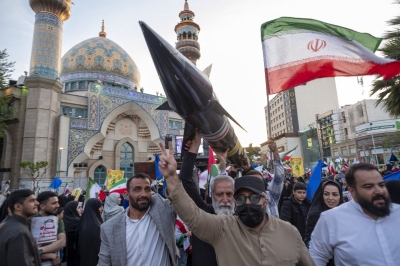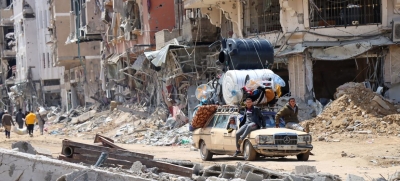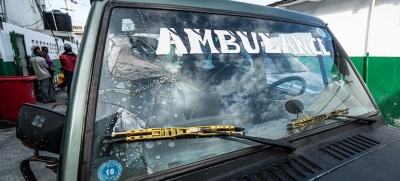What does it take to get food, medicine, emergency education, and shelter to record numbers of people in some of the most dangerous places on Earth? The UN does this around the world, including in Afghanistan, Haiti, Sudan, Ukraine, and the occupied Palestinian territory.
One in every 33 people (that’s 242 million people) on the planet needed humanitarian assistance in 2022, and most of that aid was coordinated through the UN.
Here’s how the UN does it:
Coordination: Crisis HQ
This week, as the Israel-Palestine crisis erupted on 7 October, the UN Office for the Coordination of Humanitarian Affairs (OCHA) in New York swiftly mobilized. As with all UN emergency responses, the agency facilitates efforts to deliver life-saving aid to those in need.
Taking the lead in providing relief on the ground, including in Afghanistan, Sudan, and Gaza this week, are many UN acronyms commonly identified with emergency aid worldwide, including the UN’s World Food Programme (WFP), and other such specialized agencies as those focused on refugees (UNHCR) and children (UNICEF).
A crisis team at UN Headquarters in New York works around the clock to monitor hotspots across the world. To support these efforts, the UN Department of Global Communications (DGC) amplifies emergency needs and funding appeals globally online and on social media.
UN Secretary-General António Guterres and his special envoys engage key players in each conflict to try to find a peaceful solution. In the meantime, the UN chief and staff monitor situations on the ground, inform the media of updates, and discuss with national authorities the best, safest ways to get aid to communities in crisis.
Aid hubs: World’s largest humanitarian warehouse
Planning is essential; much of the aid distributed to people in need across the world comes from storage facilities in Denmark, where UNICEF operates its Global Supply and Logistics Hub in Copenhagen.
Spanning more than 20,000 square metres, it is the largest humanitarian warehouse in the world.

A donation from Denmark, it can store up to 36,000 pallets of supplies, which are moved around by automated robot cranes.
Additional hubs are located worldwide, including in China, Italy, Panama, and the United Arab Emirates.

Walking the talk
Funding for these operations comes from nations around the world, which also donate year-round to the UN Central Emergency Response Fund (CERF). Managed by OCHA, the fund has to date provided more than $6 billion in life-saving assistance in more than 100 countries and territories.
The UN humanitarian affairs office also operates country-based funds (CBPF), managed by the UN, which makes money available to those working on the ground, including its own entities, non-governmental organizations (NGOs), and the Red Cross/Red Crescent Organizations.

OCHA allocated a record $1.2 billion through CBPF in 2022, helping partners to address the humanitarian needs of about 47 million people caught in crises.
Most recently, the UN agency released $5 million early this week to help people sheltering in Gaza and the West Bank.

How aid gets there
Boats, trucks, planes, and even drones help the UN get aid to people in need. If you’ve ever wondered just how aid supplies and relief workers themselves get to crisis-torn countries where they are needed most, it’s the UN Humanitarian Air Service that steps in when no other means of reaching isolated communities are available.
Known by its acronym, UNHAS, the service was set up in 2003, is managed by WFP, and for the past two decades has been offering safe, reliable, cost-efficient, and effective passenger and light cargo transport for the wider humanitarian community to and from areas of crisis and intervention.
UNHAS has a fleet of more than 90 aircraft, including helicopters, that transports on average more than 33,000 passengers and about 300 metric tonnes of light cargo per month to 310 regular destinations.
Drones have been also been used to reach hard-to-access areas to deliver vaccines, medicines, diagnostic samples, blood products, and other commodities, according to UNICEF, which launched the first ever humanitarian drone corridor in Africa in 2016.
Delivery routes are critical, so the UN discusses transport agreements among nations during conflicts. That included aid in Syria as well as the Black Sea Initiative, agreed by Russia, Türkiye, and Ukraine, which for one year brought more than 32 tonnes of food stuffs to 45 countries on three continents.

Safe passages: On the ground
The UN and its agencies on the ground routinely request from national authorities the establishment of humanitarian corridors, or safe, unimpeded access for aid workers and deliveries to safely reach those who need help the most.
At the national level, when emergencies occur, the UN Humanitarian and Resident Coordinator manages relief efforts, working hand-in-hand with local authorities.

But, it is UN staff, predominantly national staff with their local knowledge and contacts, that enable much of the relief work and often face the biggest risks, including those employed by the UN relief agency for Palestine refugees, UNRWA.
A dozen UN agencies and 17,000 staff members, mostly Palestine refugees, work in Gaza and the West Bank, home to more than two million people.
Despite falling rockets and closed borders, they continued to provide assistance in Gaza on Thursday, five days after the crisis began, even as the UN announced that 12 of its staff members had been killed by airstrikes.
“The humanitarian society responds despite the fact that the resources available in Gaza are not enough,” OCHA staff member Hamada El Bayari told UN News.
“There has been an almost complete stop of the supply chain, and resources have not for the last couple of days been authorized to come to Gaza,” he said. “It’s becoming, over the past days, extremely challenging for the humanitarian workers to the put their feet where the impact is.”

Did you know?
When a crisis strikes, the UN mobilizes its global network of humanitarian support, with the end goal of reaching those in need and leaving no one behind. Here are some fast facts:
- The UN provides food and assistance to more than 91.4 million people in 83 countries around the world.
- The UN supplies vaccines to almost half – 45 per cent – of the world’s children, helping to save 3 million lives every year.
- The UN assists and protects more than 71.4 million people fleeing war, famine, and persecution.





